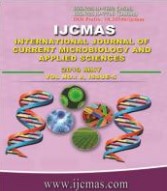


 National Academy of Agricultural Sciences (NAAS)
National Academy of Agricultural Sciences (NAAS)

|
PRINT ISSN : 2319-7692
Online ISSN : 2319-7706 Issues : 12 per year Publisher : Excellent Publishers Email : editorijcmas@gmail.com / submit@ijcmas.com Editor-in-chief: Dr.M.Prakash Index Copernicus ICV 2018: 95.39 NAAS RATING 2020: 5.38 |
Seasonal incidence of blackfly, Aleurocanthus woglumi Ashby and citrus psyllids Diaphorina citri Kuwayama were studied on acid lime during September 2017 to August 2018. The influence of weather factors on population fluctuation of sucking pests in acid lime ecosystem was recorded at weekly intervals in fixed location. The study revealed that the occurrence of sucking pests was noticed throughout the study period 36th (1st week of September) to 35th (4th week of August) standard weeks. The population of D. citri attained its first peak during 19th standard week (1stweek of May) with 23.20 nymphs/10cm length of twig. The correlation studies (r) between weather parameters and D. citri population revealed that the maximum and minimum temperatures showed significant positive relationship (r = 0.63 and 0.63 respectively), while relative humidity had significant negative relationship (r = - 0.15) with D. citri, whereas rainfall exhibited non significant relationship (r = 0.22) with D. citri. From the multiple linear regression analysis it is clear that all weather factors, had significant positively relationship. The population of A. woglumi attained its first peak during 23rd standard week (1st week of June) with 68.40 nymphs/leaf. During the present period observation, three peaks of A. woglumi were recorded, first peak coincided with 23rd standard week (1st week of June). The correlation studies (r) between weather parameters and A. woglumi population revealed that the maximum and minimum temperatures showed significant positive impact (r = 0.70 and 0.89 respectively), while the relative humidity had significant negative impact (r = - 0.22) with A. woglumi, whereas rainfall exhibited non significant relationship (r = 0.17) with A. woglumi in acid lime ecosystem. From the multiple linear regression analysis it is clear that among the weather factors, maximum and minimum temperatures had significant positive relationship, while relative humidity exhibited significant negative association with A. woglumi in acid lime ecosystem.
 |
 |
 |
 |
 |